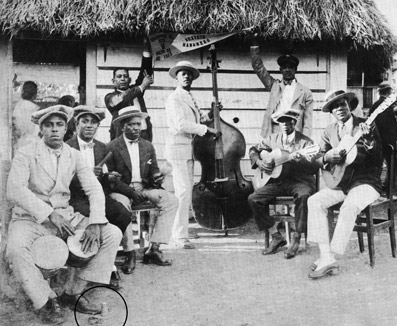
Sexteto Habanero 1925.
ソン・クバーノ
Son cubano

Sexteto Habanero 1925.
☆ ソン・クバーノは、19世紀後半にキューバ東部の高地で生まれた音楽とダンスのジャンルである。スペインとアフリカの要素が融合したシンクレティックな ジャンルである。基本的なヒスパニックの構成要素としては、ヴォーカル・スタイル、叙情的な拍子、スペインのギターに由来するトレスの優位性が挙げられ る。一方、特徴的なクラーベのリズム、コール・アンド・レスポンスの構造、パーカッション・セクション(ボンゴ、マラカスなど)は、すべてバントゥー語起 源の伝統に根ざしている。
| Son cubano
is a genre of music and dance that originated in the highlands of
eastern Cuba during the late 19th century. It is a syncretic genre that
blends elements of Spanish and African origin. Among its fundamental
Hispanic components are the vocal style, lyrical metre and the primacy
of the tres, derived from the Spanish guitar. On the other hand, its
characteristic clave rhythm, call and response structure and percussion
section (bongo, maracas, etc.) are all rooted in traditions of Bantu
origin.[1] Around 1909 the son reached Havana, where the first recordings were made in 1917.[2] This marked the start of its expansion throughout the island, becoming Cuba's most popular and influential genre.[3] While early groups had between three and five members, during the 1920s the sexteto (sextet) became the genre's primary format. By the 1930s, many bands had incorporated a trumpet, becoming septetos, and in the 1940s a larger type of ensemble featuring congas and piano became the norm: the conjunto. The son became one of the main ingredients in the jam sessions known as descargas that flourished during the 1950s. The international presence of the son can be traced back to the 1930s when many bands toured Europe and North America, leading to ballroom adaptations of the genre such as the American rhumba. Similarly, radio broadcasts of son became popular in West Africa and the Congos, leading to the development of hybrid genres such as Congolese rumba. In the 1960s, New York's music scene prompted the rapid success of salsa, a combination of son and other Latin American styles primarily recorded by Puerto Ricans. While salsa achieved international popularity during the second half of the 20th century, in Cuba son evolved into other styles such as songo and timba, the latter of which is sometimes known as "Cuban salsa". |
ソ
ン・クバーノは、19世紀後半にキューバ東部の高地で生まれた音楽とダンスのジャンルである。スペインとアフリカの要素が融合したシンクレティックなジャ
ンルである。基本的なヒスパニックの構成要素としては、ヴォーカル・スタイル、叙情的な拍子、スペインのギターに由来するトレスの優位性が挙げられる。一
方、特徴的なクラーベのリズム、コール・アンド・レスポンスの構造、パーカッション・セクション(ボンゴ、マラカスなど)は、すべてバントゥー語起源の伝
統に根ざしている[1]。 1909年頃、ソンはハバナに到達し、1917年に最初のレコーディングが行われた[2]。これがキューバ全土への拡大の始まりとなり、キューバで最も人 気があり影響力のあるジャンルとなった[3]。初期のグループは3人から5人のメンバーであったが、1920年代にはセクステト(六重奏)がこのジャンル の主要な形式となった。1930年代には、多くのバンドがトランペットを加えてセプテットとなり、1940年代には、コンガとピアノをフィーチャーしたよ り大きなタイプのアンサンブル、コンジュントが主流となった。ソンは、1950年代に盛んになったデスカルガと呼ばれるジャムセッションの主要な材料のひ とつとなった。 ソンの国際的な存在感は、多くのバンドがヨーロッパと北米をツアーした1930年代にまで遡ることができ、アメリカのルンバのようなこのジャンルの社交場 でのアレンジにつながった。同様に、西アフリカやコンゴでもソンのラジオ放送が人気を博し、コンゴ・ルンバのようなハイブリッドなジャンルの発展につな がった。1960年代、ニューヨークの音楽シーンは、主にプエルトリコ人によって録音されたソンと他のラテン・アメリカン・スタイルの組み合わせであるサ ルサの急速な成功を促した。サルサは20世紀後半に国際的な人気を獲得したが、キューバでは、ソンはソンゴやティンバといった他のスタイルに進化し、後者 は「キューバ・サルサ」として知られることもある。 |
| Etymology and cognates In Spanish, the word son, from Latin sonus, denotes a pleasant sound, particularly a musical one.[4] In eastern Cuba, the term began to be used to refer to the music of the highlands towards the late 19th century. To distinguish it from similar genres from other countries (such as son mexicano and son guatemalteco), the term son cubano is most commonly used. In Cuba, various qualifiers are used to distinguish the regional variants of the genre. These include son montuno, son oriental, son santiaguero and son habanero.[2] Son singers are generally known as soneros, and the verb sonear describes not only their singing but also their vocal improvisation.[5] The adjective soneado refers to songs and styles which incorporate the tempo and syncopation of the son, or even its montunos. Generally, there is an explicit difference between styles that incorporate elements of the son partially or totally, as evidenced by the distinction between bolero soneado and bolero-son.[6][7] The term sonora refers to conjuntos with smoother trumpet sections such as Sonora Matancera and Sonora Ponceña.[8] |
語源と同義語 スペイン語では、ラテン語のsonusを語源とするsonは、心地よい音、特に音楽的な音を表す[4]。キューバ東部では、19世紀後半から高地の音楽を 指す言葉として使われ始めた。他国の類似ジャンル(ソン・メキシコやソン・グアテマルテコなど)と区別するため、ソン・クバーノという呼称が最も一般的に 用いられている。キューバでは、このジャンルの地域的な変種を区別するために、さまざまな修飾語が使われている。例えば、ソン・モントゥーノ、ソン・オリ エンタル、ソン・サンティアゲーロ、ソン・ハバネロなどである[2]。 ソンの歌手は一般的にソネーロス(soneros)と呼ばれ、ソネア(sonear)という動詞は彼らの歌唱だけでなく、即興的な発声も表す[5]。ソネ アド(soneado)という形容詞は、ソンのテンポやシンコペーション、あるいはモントゥーノ(montunos)を取り入れた歌やスタイルを指す。一 般的に、ボレロ・ソネアドとボレロ・ソンの区別に見られるように、ソンの要素を部分的に取り入れたスタイルと完全に取り入れたスタイルとの間には明確な違 いがある[6][7]。ソノーラという用語は、ソノーラ・マタンセラやソノーラ・ポンセーニャのような、より滑らかなトランペット・セクションを持つコン ジュントを指す[8]。 |
| History Origins 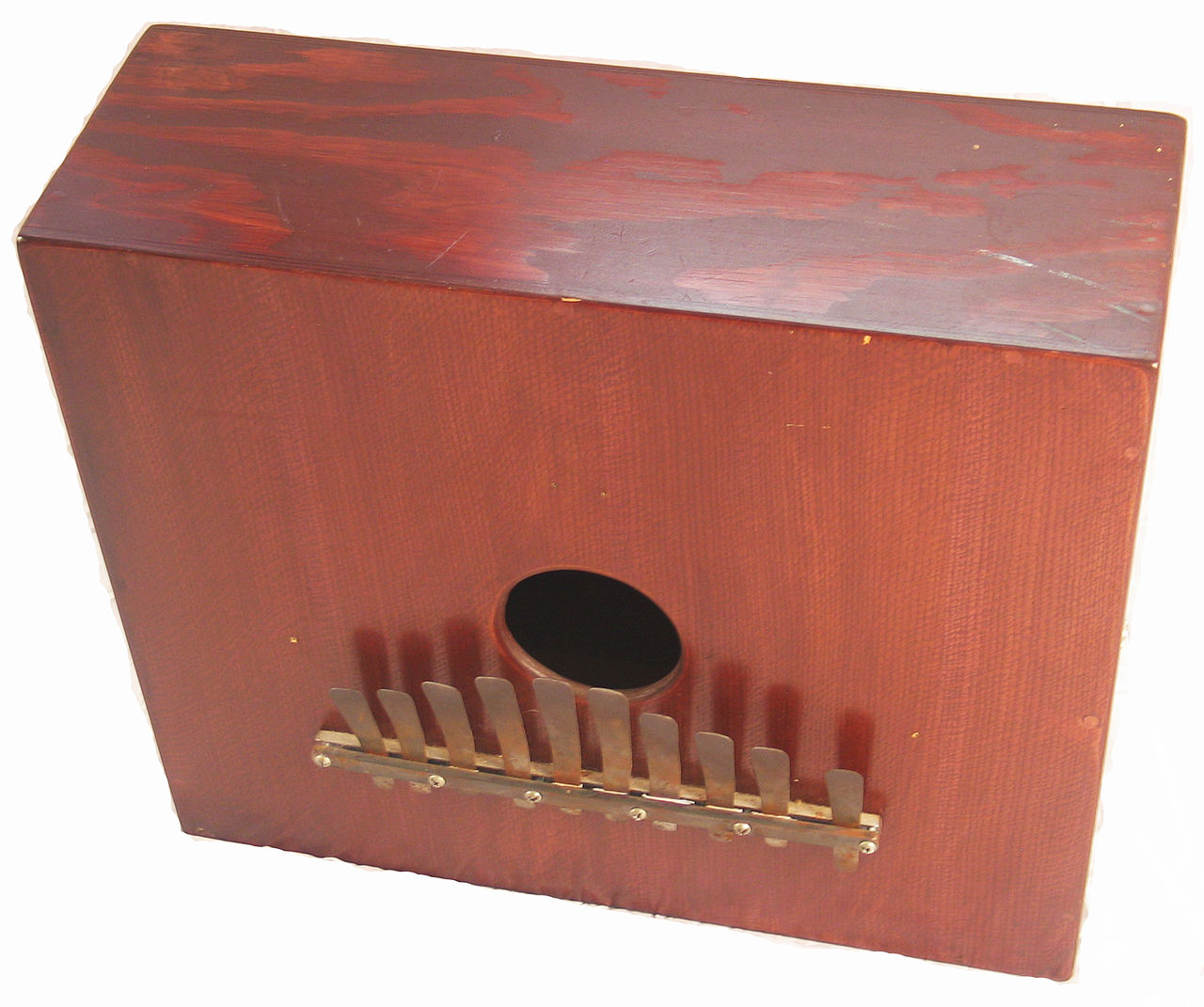 A marímbula, the "bass" instrument used by changüí ensembles. Some groups used the more rudimentary jug known as botija or botijuela. Although the history of Cuban music dates back to the 16th century, the son is a relatively recent musical invention whose precursors emerged in the mid-to-late 19th century. Historically, most musicologists have supported the hypothesis that the direct ancestors (or earliest forms) of the son appeared in Cuba's Oriente Province, particularly in mountainous regions such as Sierra Maestra.[2] These early styles, which include changüí, nengón, kiribá and regina,[9] were developed by peasants, many of which were of Bantu origin, in contrast to the Afro-Cubans of the western side of the island, which primarily descended from West African slaves (Yoruba, Ewe, etc.).[1] These forms flourished in the context of rural parties such as guateques, where bungas were known to perform; these groups consisted of singers and guitarists playing variants such as the tiple, bandurria and bandola.[10] Such early guitars are thought to have given rise to the tres some time around 1890 in Baracoa.[11] The addition of a rhythm section composed of percussion instruments such as the bongó and the botija/marímbula gave rise to the first son groups proper.[12] Nonetheless, it has become increasingly clear for musicologists that different versions of the son, i.e. styles that fall within the so-called son complex, appeared throughout the rural parts of the island by the end of the 1890s.[13] Musicologist Marta Esquenazi Pérez divides the son complex into three regional variants: changüí in Guantánamo, sucu-sucu in Isla de la Juventud, and an array of styles which fall under the denomination of son montuno and were developed in places such as Bayamo, Manzanillo, Majagua and Pinar del Río.[14] For this reason, some academics such as Radamés Giro and Jesús Gómez Cairo indicate that awareness of the son was widespread in the whole island, including Havana, before the actual expansion of the genre in the 1910s.[15][16] Musicologist Peter Manuel proposed an alternative hypothesis according to which a great deal of the son's structure originated from the contradanza in Havana around the second half of the 19th century. The contradanza included many of the traits that are shown in the son, such as duets with melodies in parallel thirds, the presence of a suggested clave rhythm, implicit short vocal refrains borrowed from popular songs, distinctive syncopations, as well as the two-parts song form with an ostinato section.[17] Apocryphal origins of the son Due to the very limited historiographical and ethnomusicological research devoted to the son (considered by Díaz Ayala the "least studied" Cuban genre),[2] until the mid-20th century its origins were incorrectly traced back to the 16th century by many writers. This fallacy stemmed from the apocryphal origin story of a folk song known as "Son de Má Teodora". Such story was first mentioned by Cuban historian Joaquín José García in 1845, who "cited" a chronicle supposedly written by Hernando de la Parra in the 16th century. Parra's story was picked up, recycled and expanded by various authors throughout the second half of the 19th century, perpetuating the idea that such song was the first example of the son genre. Despite being given credence by some authors in the first half of the 20th century, including Fernando Ortiz, the Crónicas were repeatedly shown to be apocryphal in subsequent studies by Manuel Pérez Beato, José Juan Arrom, Max Henríquez Ureña and Alberto Muguercia.[18] |
沿革 起源  チャングイのアンサンブルで使われる "ベース "楽器、マリンブラ。ボティージャ(botija)またはボティジュエラ(botijuela)として知られる、より初歩的な水差しを使うグループもある。 キューバ音楽の歴史は16世紀まで遡るが、ソンは比較的最近になって発明された音楽であり、その前身は19世紀半ばから後半にかけて登場した。歴史的に は、ほとんどの音楽学者は、ソンの直接の祖先(または最も初期の形態)はキューバのオリエンテ州、特にシエラ・マエストラのような山岳地帯に現れたという 仮説を支持している。 2]これらの初期の様式は、チャングイ(changüí)、ネンゴン(nengón)、キリバ(kiribá)、レジーナ(regina)を含み[9]、 主に西アフリカの奴隷(ヨルバ(Yoruba)、エウェ(Ewe)等)の子孫である島の西側のアフロ・キューバ人とは対照的に、その多くがバントゥー系で ある農民によって発展した[1]。 これらの形態は、ブンガが演奏することで知られていたグアテケス(guateques)のような農村のパーティーの文脈で栄えた。これらのグループは、 ティプル、バンドゥリア、バンドーラなどの変種を演奏する歌い手とギタリストによって構成されていた[10]。 [11]ボンゴやボティージャ/マリンブラといった打楽器で構成されるリズム・セクションが加わることで、最初のソン・グループが誕生した[12]。それ にもかかわらず、音楽学者にとっては、1890年代の終わりまでに、ソンの異なるバージョン、いわゆるソン・コンプレックスに分類されるスタイルが、島の 農村部全体に出現していたことが次第に明らかになってきた。 [13]音楽学者のマルタ・エスケナージ・ペレスは、ソン・コンプレックスを、グアンタナモのchangüí、フベントゥ島(Isla de la Juventud)のsucu-sucu、そしてバヤモ、マンサニージョ、マジャグア、ピナール・デル・リオなどで発展したソン・モントゥーノ(Son Montuno)と呼ばれるスタイルの3つの地域的なバリエーションに分類している。 [14]このため、ラダメス・ジロやヘスス・ゴメス・カイロのような学者の中には、1910年代にこのジャンルが実際に拡大する以前に、ハバナを含む島全 体にソンに対する認識が広まっていたと指摘する者もいる[15][16]。 音楽学者ピーター・マニュエルは、19世紀後半にハバナで行われたコントラプダンツァからソンの構造の多くが生まれたという代替仮説を提唱した。コンディ トアンサには、平行三度拍子の旋律による二重唱、暗示的なクラーヴェのリズムの存在、ポピュラー・ソングから借用した暗黙の短いヴォーカル・リフレイン、 特徴的なシンコペーション、オスティナート・セクションを持つ二部構成の歌の形式など、ソンに見られる特徴の多くが含まれていた[17]。 ソンのアポクリファル的起源 ソン(ディアス・アヤラはキューバで「最も研究されていない」ジャンルだと考えている)[2]に費やされた歴史学的・民族音楽学的研究は非常に限られてい たため、20世紀半ばまで、その起源は多くの作家によって誤って16世紀まで遡るものとされていた。この誤りは、"Son de Má Teodora "として知られる民謡のアポクリファルな起源物語に由来する。このような話は、1845年にキューバの歴史家ホアキン・ホセ・ガルシアによって初めて言及 され、彼は16世紀にエルナンド・デ・ラ・パラが書いたとされる年代記を「引用」した。パラの話は、19世紀後半を通じて様々な作家によって取り上げら れ、再利用され、拡大され、このような歌がソンというジャンルの最初の例であるという考えが広まった。20世紀前半には、フェルナンド・オルティスを含む 何人かの作家によって信憑性が持たれていたにもかかわらず、マヌエル・ペレス・ベアト、ホセ・フアン・アロム、マックス・ヘンリケス・ウレーニャ、アルベ ルト・ムグエルシアらによるその後の研究で、クロニカスは繰り返し偽書であることが示された[18]。 |
| Early 20th century The emergence of son significantly increased the interaction of cultures derived from Africa and Spain. A large number of former black slaves, recently liberated after the abolition of slavery in 1886 went to live in the slums "solares" of low class neighborhoods in Havana, and numerous laborers also arrived from all over the country and some rural areas, looking to improve their living conditions. Many of them brought their Afro-Cuban rumba traditions, and others brought their rumbitas and montunos. It was in Havana where the encounter of the rumba rural and the rumba urbana that had been developing separately during the second half of the 19th century took place. The guaracheros and rumberos who used to play with the tiple and the guiro finally met other rumberos who sang and danced accompanied by the wooden box (cajón) and the Cuban clave, and the result was the fusion of both styles in a new genre called son.[19] Around 1910 the son most likely adopted the clave rhythm from the Havana-based rumba, which had been developed in the late 19th century in Havana and Matanzas.[20] After trovador Sindo Garay settled in Havana in 1906, many other trovadores followed him hoping to obtain a recording contract with one of the American Companies such as RCA Victor and Columbia Records. Those trovadores from different parts of the country met others who already lived in Havana such as María Teresa Vera and Rafael Zequeira. They brought their repertoires of canciones (Cuban songs) and boleros that also included rumbas, guarachas and rural rumbitas. Famous trovador Chico Ibáñez said that he composed his first "montuno" called "Pobre Evaristo" (Poor Evaristo) in 1906: "It was a tonada with three or four words that you put on, and after it, we placed a repeated phrase, the real montuno to be sung by everybody…".[21] Ned Sublette states about another famous trovador and sonero: "As a child, Miguel Matamoros played danzones and sones on his harmonica to entertain the workers at a local cigar factory. He said: 'the sones that were composed at that time were nothing more than two or three words that were repeated all night long.'"[22] A partial list of trovadores that recorded rumbas, guarachas and sones in Havana at the beginning of the 20th century included: Sindo Garay, Manuel Corona, María Teresa Vera, Alberto Villalón, José Castillo, Juan Cruz, Juan de la Cruz, Nano León, Román Martínez, as well as the duos of Floro and Zorrilla, Pablito and Luna, Zalazar and Oriche, and also Adolfo Colombo, who was not a trovador but a soloist at Teatro Alhambra.[23] In the Havana neighborhoods, the son groups played in any possible format they could gather and most of them were semi-professional. One of those groups, The Apaches, was invited in 1916 to a party held by President Mario Menocal at the exclusive Vedado Tennis Club, and that same year some members of the group were reorganized in a quartet named Cuarteto Oriental.[24] Those members were: Ricardo Martínez from Santiago de Cuba (conductor and tres), Gerardo Martínez (first voice and clave), Guillermo Castillo (botijuela), and Felipe Neri Cabrera (maracas). According to Jesús Blanco, quoted by Díaz Ayala, after a few months from its foundation the bongocero Joaquín Velazco joined the group.[25] In 1917, the Cuarteto Oriental recorded the first son documented on the catalog of Columbia Records which was entered as "Pare motorista-son santiaguero". Unexpectedly, a fifth member of the quartet is mentioned, Carlos Godínez, who was a soldier in the standing army (Ejército Permanente). Subsequently, the RCA Victor contracted Godínez in 1918 to organize a group and record several songs. For that recording, the new group was called "Sexteto Habanero Godínez", which included: Carlos Godínez (conductor and tresero), María Teresa Vera (first voice and clave), Manuel Corona (second voice and guitar), Sinsonte (third voice and maracas), Alfredo Boloña (bongo), and another unknown performer who was not included in the list.[26] |
20世紀初頭 ソンの出現により、アフリカとスペインに由来する文化の交流が著しく盛んになった。1886年の奴隷制度廃止後、解放されたばかりの元黒人奴隷の多くがハ バナの下層階級が住むスラム街「ソラーレス」に住み始め、また全国各地や一部の地方からも、生活環境の改善を求めて多くの労働者がやってきた。彼らの多く はアフロ・キューバン・ルンバの伝統を持ち込み、また他の人々はルンビータやモントゥーノを持ち込んだ。 19世紀後半に別々に発展していた田舎のルンバと都会のルンバが出会ったのはハバナだった。ティプルとギロで演奏していたグアラチェロとルンベロは、木製 の箱(カホン)とキューバのクラーヴェを伴奏に歌い踊る他のルンベロとついに出会い、その結果、両方のスタイルが融合してソンと呼ばれる新しいジャンルと なった[19]。1910年頃、ソンは、19世紀後半にハバナやマタンサスで発展したハバナのルンバからクラーヴェのリズムを取り入れた可能性が高い [20]。 1906年にトロヴァドール・シンド・ガライがハバナに定住した後、多くのトロヴァドールがRCAビクターやコロンビア・レコードといったアメリカの会社 とレコーディング契約を結ぶことを望んで彼に続いた。国内各地からやってきたトロヴァドールたちは、マリア・テレサ・ベラやラファエル・ゼケイラのよう な、すでにハバナに住んでいた人たちと知り合った。彼らは、ルンバ、グアラチャ、田舎のルンビタスを含むカンシオン(キューバの歌)やボレロのレパート リーを持ち寄った。 有名なトロバドール、チコ・イバニェスは、1906年に "Pobre Evaristo"(哀れなエバリスト)という最初の "montuno "を作曲したと語っている: 「それは、3つか4つの単語を載せたトナーダで、その後に、繰り返しのフレーズを載せたんだ。彼は『当時作曲されたソネは、一晩中繰り返される2つか3つ の言葉に過ぎなかった』と言っている」[22]。 20世紀初頭にハバナでルンバ、グアラチャス、ソネを録音したトロバドールのリストの一部: シンド・ガライ、マヌエル・コロナ、マリア・テレサ・ベラ、アルベルト・ビジャロン、ホセ・カスティーリョ、フアン・クルス、フアン・デ・ラ・クルス、ナ ノ・レオン、ロマン・マルティネス、また、フロロとゾリージャ、パブリートとルナ、サラザールとオリチェのデュオや、トロバドールではなくアルハンブラ劇 場のソリストだったアドルフォ・コロンボなどがいる[23]。 ハバナ近郊では、ソングループたちは集められる限りのあらゆる形式で演奏し、そのほとんどはセミプロだった。それらのグループのひとつであるアパッチは、 1916年にマリオ・メノカル大統領が高級なヴェダド・テニスクラブで開催したパーティーに招待され、同じ年にグループの何人かのメンバーはクアルテー ト・オリエンタルという名のカルテットに再編成された[24]: サンティアゴ・デ・クーバ出身のリカルド・マルティネス(指揮とトレス)、ジェラルド・マルティネス(第一声とクラーベ)、ギジェルモ・カスティージョ (ボティウエラ)、フェリペ・ネリ・カブレラ(マラカス)。ディアス・アヤラによって引用されたヘスス・ブランコによると、結成から数ヶ月後にボンゴセロ のホアキン・ヴェラスコが加入した[25]。 1917年、クアルテート・オリエンタルは、コロンビア・レコードのカタログに「Pare motorista-son santiaguero(パレ・モトリスタ・ソン・サンティアゲーロ)」として記録された最初のソンを録音した。カルテットの5人目のメンバーは、常備軍 (Ejército Permanente)の兵士であったカルロス・ゴディネス(Carlos Godínez)であった。その後、RCAビクターは1918年にゴディネスと契約し、グループを結成して数曲を録音した。そのレコーディングのために、 新しいグループは "セクステート・ハバネロ・ゴディネス "と呼ばれ、以下のメンバーで構成された: カルロス・ゴディネス(指揮者、トレセーロ)、マリア・テレサ・ベラ(第一声、クラーヴェ)、マヌエル・コロナ(第二声、ギター)、シンソンテ(第三声、 マラカス)、アルフレード・ボローニャ(ボンゴ)、そしてもう一人、リストに含まれていない無名の演奏家がいた[26]。 |
1920s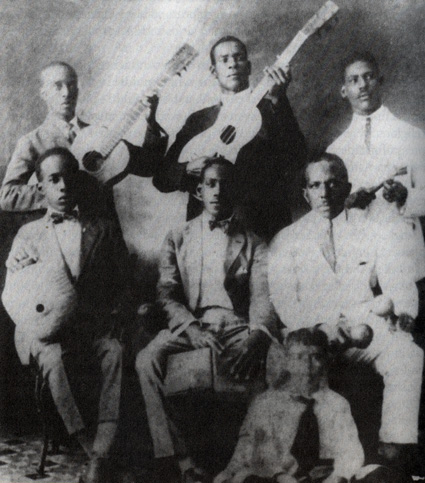 Sexteto Habanero 1920. In 1920, the Cuarteto Oriental became a sextet and was renamed as Sexteto Habanero. This group established the "classical" configuration of the son sextet composed of guitar, tres, bongos, claves, maracas and double bass.[27] The sextet members were: Guillermo Castillo (conductor, guitar and second voice), Gerardo Martínez (first voice), Felipe Neri Cabrera (maracas and backing vocals), Ricardo Martínez (tres), Joaquín Velazco (bongos), and Antonio Bacallao (botija). Abelardo Barroso, one of the most famous soneros, joined the group in 1925.[28]  Sexteto Habanero 1925. Popularization began in earnest with the arrival of radio broadcasting in 1922, which came at the same time as Havana's reputation as an attraction for Americans evading Prohibition laws. The city became a haven for the Mafia, gambling and prostitution in Cuba, and also became a second home for trendy and influential bands from New York City. The son experienced a period of transformation from 1925 to 1928, when it evolved from a marginal genre of music to perhaps the most popular type of music in Cuba. 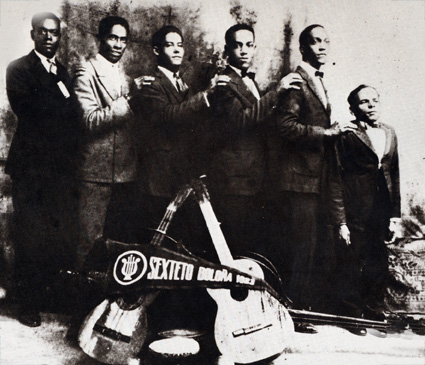 Sexteto Boloña 1926. A turning point that made this transformation possible occurred when then-president Machado publicly asked La Sonora Matancera to perform at his birthday party. In addition, the acceptance of son as a popular music genre in other countries contributed to more acceptance of son in mainstream Cuba.[29] At that time many sextets were founded such as Boloña, Agabama, Botón de Rosa and the famous Sexteto Occidente conducted by María Teresa Vera.[28]  Sexteto Occidente, New York 1926 back: María Teresa Vera (guitar), Ignacio Piñeiro (double bass), Julio Torres Biart (tres); front: Miguelito Garcia (clave), Manuel Reinoso (bongo) and Francisco Sánchez (maracas) A few years later, in the late 1920s, son sextets became septets and son's popularity continued to grow with artists like Septeto Nacional and its leader Ignacio Piñeiro ("Echale salsita", "Donde estabas anoche"). In 1928, Rita Montaner's "El Manicero" became the first Cuban song to be a major hit in Paris and elsewhere in Europe. In 1930, Don Azpiazu's Havana Casino Orchestra took the song to the United States, where it also became a big hit. The instrumentation was expanded to include cornets or trumpets, forming the sextets and the septets of the 1920s. Later these conjuntos added piano, other percussion instruments, more trumpets, and even dance orchestra instruments in the style of jazz big bands.[30] |
1920s セクステート・ハバネロ 1920年 1920年、クアルテート・オリエンタルはセクステットとなり、セクステート・ハバネロと改名。このグループは、ギター、トレス、ボンゴ、クラベス、マラ カス、コントラバスで構成されるソン六重奏団の「古典的な」構成を確立した[27]: ギジェルモ・カスティージョ(指揮者、ギター、第二声)、ジェラルド・マルティネス(第一声)、フェリペ・ネリ・カブレラ(マラカス、バッキング・ヴォー カル)、リカルド・マルティネス(トレス)、ホアキン・ベラスコ(ボンゴ)、アントニオ・バカリャオ(ボティージャ)。最も有名なソネーロの一人であるア ベラルド・バロソは1925年にグループに加入した[28]。  セクステート・ハバネロ 1925年 1922年にラジオ放送が開始されると、本格的な大衆化が始まり、ハバナは禁酒法から逃れたアメリカ人の誘致地として知られるようになった。キューバでは マフィア、ギャンブル、売春の天国となり、またニューヨークから来た流行の最先端を行く影響力のあるバンドの第2の故郷となった。1925年から1928 年にかけて、ボローニャは変貌を遂げ、キューバで最も人気のある音楽へと発展した。  セクステート・ボローニャ 1926年 この変貌を可能にした転機は、当時のマチャド大統領がラ・ソノラ・マタンセラに対し、自身の誕生日パーティーでの演奏を公に依頼したことによる。当時、ボ ローニャ、アガバマ、ボトン・デ・ロサ、そしてマリア・テレサ・ベラが指揮する有名なセクステート・オクシデンテなど、多くのセクステートが結成された [28]。  セクステート・オクシデンテ、ニューヨーク 1926年 後ろ マリア・テレサ・ベラ(ギター)、イグナシオ・ピニェイロ(コントラバス)、フリオ・トーレス・ビアルト(トレス)、手前: ミゲリート・ガルシア(クラーベ)、マヌエル・レイノソ(ボンゴ)、フランシスコ・サンチェス(マラカス) 数年後の1920年代後半には、ソン六重奏団は七重奏団となり、ソンの人気はセプテート・ナシオナルやそのリーダー、イグナシオ・ピニェイロ ("Echale salsita"、"Donde estabas anoche")などのアーティストによって高まり続けた。1928年、リタ・モンタネールの "El Manicero "がキューバで初めてパリやヨーロッパで大ヒットした。1930年、ドン・アスピアズのハバナ・カジノ・オーケストラがこの曲をアメリカに持ち帰り、ここ でも大ヒットとなった。 楽器編成は、1920年代の六重奏団や七重奏団を形成するコルネットやトランペットにまで拡大された。その後、これらのコンジュントにはピアノ、その他の 打楽器、トランペットが加わり、ジャズのビッグバンドのスタイルでダンス・オーケストラの楽器も使われるようになった[30]。 |
| Trío Matamoros The presence of the Trío Matamoros in the history of Cuban son is so important that it deserves a separate section. Its development constitutes an example of the process that the trovadores usually followed until they became soneros. The Trío was founded by Miguel Matamoros (vocals and first guitar), who was born in Santiago de Cuba (Oriente) in 1894. There, he became involved with the traditional trova movement and in 1925 joined Siro Rodríguez (vocals and maracas) and Rafael Cueto (vocals and second guitar) to create the famous group.[31] They synthesized the style of the sextets and septets, adapting it to their ensemble. The different rhythmic layers of the son style were distributed between their three voices, guitars and maracas. Cueto plucked the strings of his guitar instead of strumming them as it was usual, providing the patterns of the guajeo in the treble range, and the syncopated rhythms of the tumbao on the bass strings. The counterpoint was completed by the first guitar, played by Matamoros.[32] They also occasionally included other instruments such as the bongo, and later they decided to expand the trio format to create a son conjunto by adding a piano, more guitars, tres and other voices. This project was joined by such important figures as Lorenzo Hierrezuelo, Francisco Repilado (Compay Segundo) and Beny Moré. In 1928, they travelled to New York with a recording contract by RCA Victor, and their first album caused such a great impact in the public that they soon became very famous at a national as well as an international level. The Trío Matamoros maintained great prominence until their official retirement in 1960.[28] 1930s By the late 1930s, the heyday of "Classic son" had largely ended. The sextetos and septetos that had enjoyed wide commercial popularity increasingly lost ground to jazz bands and amplified conjuntos.[33] The very music that son had helped to create was now replacing son as the more popular and most requested music in Cuba. Original son conjuntos were faced with the options of either to disband and refocus on newer styles of Cuban music, or go back to their roots. 1940s 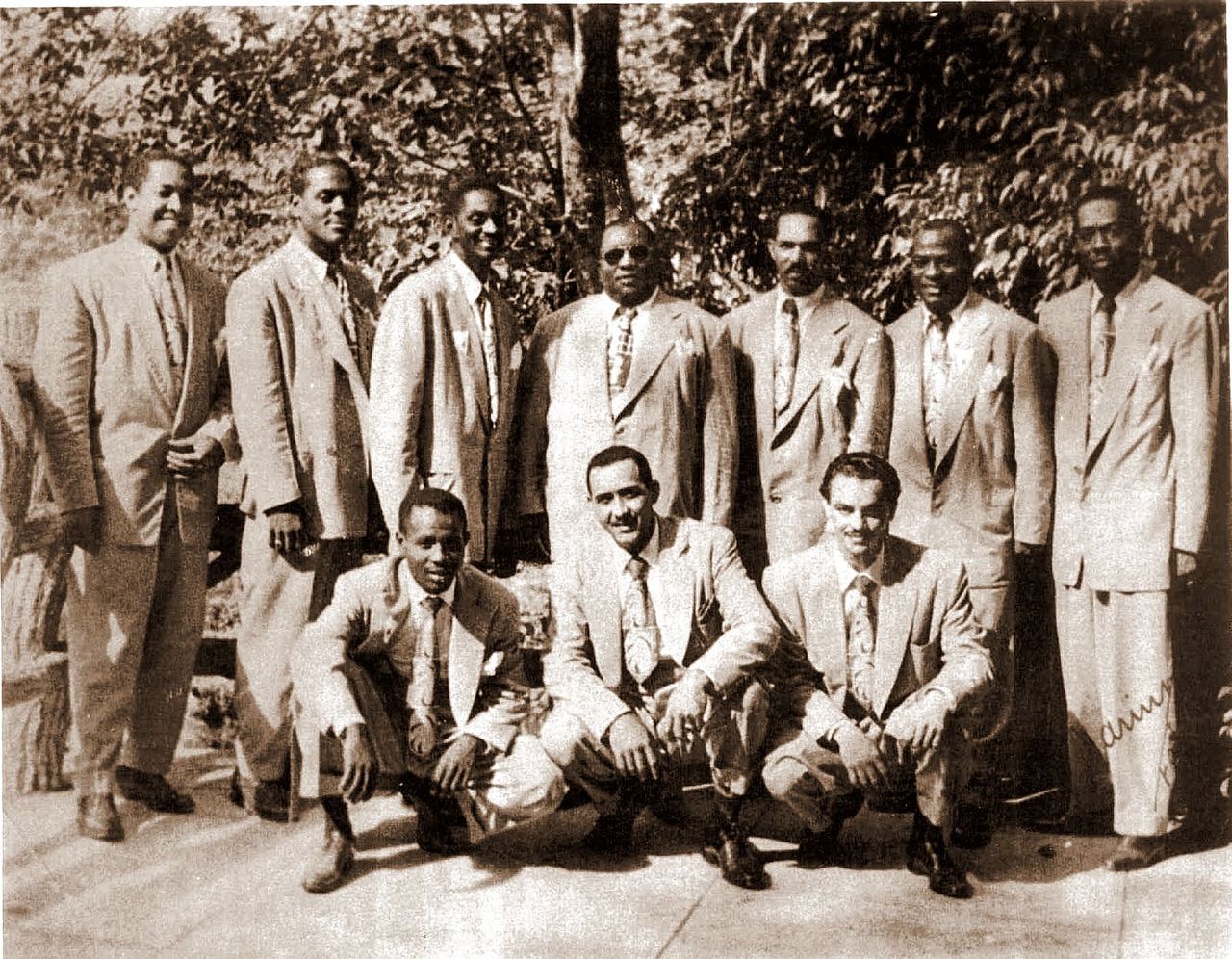 Conjunto de Arsenio Rodríguez ca. 1949. In the 1940s, Arsenio Rodríguez became the most influential player of son. He used improvised solos, toques, congas, extra trumpets, percussion and pianos, although all these elements had been used previously ("Papauba", "Para bailar son montuno"). Beny Moré (known as El Bárbaro del Ritmo, "The Master of Rhythm") further evolved the genre, adding guaracha, bolero and mambo influences. He was perhaps the greatest sonero ("Castellano que bueno baila usted", "Vertiente Camaguey"); another important sonero was Roberto Faz. By the late 1940s, son had lost its controversiality even among conservative Cubans which made it even less appealing to Cubans.[34] A development that led to the decrease in popularity of the original son occurred in the 1940s. The son grew more sophisticated as it was adopted by conjuntos, which displaced sextetos and septetos. This led to big bands replacing the conjuntos, which managed to keep its flavor despite elaborate arrangements.[35] During the 1940s and 1950s, the tourism boom in Cuba and the popularity of jazz and American music in general fostered the development of big bands and combos on the island. These bands consisted of a relatively small horn section, piano, double bass, a full array of Cuban percussion instruments and a vocalist fronting the ensemble. Their polished sound and "cosmopolitan" – read "commercial" – repertoire captivated both Cuban and foreign audiences. The commercialism of this new music movement led Cuban nightclub owners to recognize the revenue potential of hosting these types of bands to attract the growing flow of tourists. Additionally, as a result of the increasing popularity of big band music and in an effort to increase revenues, the recording industry focused on producing newer types of music and essentially removing son from their music repertoires. These developments were a big blow to the prospects of son and its popularity amongst even Cubans. With the arrival of cha-cha-chá and mambo in the United States, son also became extremely popular. After the Cuban Revolution separated Cuba from the U.S., son, mambo and rumba, along with other forms of Afro-Cuban music contributed to the development of salsa music, initially in New York.[36] The mass popularization of son music led to an increased valorization of Afro-Cuban street culture and of the artists who created it. It also opened the door for other music genres with Afro-Cuban roots to become popular in Cuba and throughout the world.[33] |
トリオ・マタモロス キューバ・ソンの歴史におけるトリオ・マタモロスの存在は、独立したセクションを設けるに値するほど重要である。その発展は、トロヴァドールがソネーロス になるまでにたどったプロセスの一例である。トリオは、1894年にサンティアゴ・デ・クーバ(オリエンテ)で生まれたミゲル・マタモロス(ヴォーカルと ファースト・ギター)によって結成された。彼はそこで伝統的なトローバ・ムーヴメントに関わり、1925年にシロ・ロドリゲス(ヴォーカル、マラカス)と ラファエル・クエト(ヴォーカル、セカンド・ギター)と共に有名なグループを結成した[31]。 彼らは六重奏団や七重奏団のスタイルを自分たちのアンサンブルに適応させながら統合した。ソン・スタイルの異なるリズムのレイヤーは、3人の声、ギター、 マラカスに分配された。クエトはギターの弦を通常のようにかき鳴らす代わりに弾き、高音域にグアヘオのパターンを、低音弦にトゥンバオのシンコペーション のリズムを提供した。対位法は、マタモロスが弾く1本目のギターによって完成された[32]。彼らは、時折ボンゴなどの他の楽器も取り入れ、後にトリオの 形式を拡大し、ピアノ、より多くのギター、トレス、その他の声楽を加えてソン・コンジュントを作ることにした。このプロジェクトには、ロレンソ・ヒエレス エロ、フランシスコ・レピラド(コンペイ・セグンド)、ベニー・モレといった重要人物が加わった。 1928年、彼らはRCAビクターとレコーディング契約を結んでニューヨークに渡り、彼らの最初のアルバムは世間に大きな衝撃を与え、すぐに国内だけでな く国際的にも非常に有名になった。トリオ・マタモロスは、1960年に正式に引退するまで、大きな名声を維持した[28]。 1930s 1930年代後半には、"クラシック・ソン "の全盛期はほぼ終わりを告げた。ソンが創作に貢献した音楽は、今やソンに代わってキューバで最もポピュラーでリクエストの多い音楽となりつつあった [33]。オリジナルのソン・コンジュントは、解散して新しいスタイルのキューバ音楽に再注目するか、ルーツに戻るかの選択肢に迫られた。 1940s  1949年頃のアルセニオ・ロドリゲスのコンフント。 1940年代、アルセニオ・ロドリゲスはソンで最も影響力のあるプレイヤーになった。彼は即興ソロ、トーケ、コンガ、トランペット、パーカッション、ピア ノを使用したが、これらの要素は以前にも使用されていた("Papauba"、"Para bailar son montuno")。ベニー・モレ(El Bárbaro del Ritmo、「リズムの達人」として知られる)は、このジャンルをさらに進化させ、グアラチャ、ボレロ、マンボの影響を加えた。彼はおそらく最も偉大なソ ネーロであった("Castellano que bueno baila usted"、"Vertiente Camaguey")。 1940年代後半になると、ソンは保守的なキューバ人の間でさえ論争的な要素を失い、キューバ人にとってソンの魅力はさらに薄れていった[34]。6重奏 や7重奏の代わりにコンジュントが採用されたことで、ソンはより洗練されたものになった。その結果、ビッグバンドがコンジュントスに取って代わるようにな り、手の込んだアレンジにもかかわらず、その趣を保つことに成功した[35]。 1940年代から1950年代にかけて、キューバでは観光ブームとジャズやアメリカ音楽全般の人気がビッグバンドやコンボの発展を促した。これらのバンド は、比較的少人数のホーン・セクション、ピアノ、コントラバス、キューバの打楽器一式、そしてアンサンブルの前座を務めるヴォーカリストで構成されてい た。彼らの洗練されたサウンドと「コスモポリタン」なレパートリーは、キューバと外国の聴衆を魅了した。 この新しい音楽ムーブメントの商業主義によって、キューバのナイトクラブのオーナーは、増加する観光客の流れを引き寄せるために、この種のバンドを主催す ることの収益の可能性を認識するようになった。さらに、ビッグバンド・ミュージックの人気が高まり、収入を増やそうとした結果、レコーディング業界は新し いタイプの音楽の制作に力を入れ、実質的に彼らの音楽のレパートリーからソンを排除した。こうした動きは、ソンの将来性とキューバ人の間でのソン人気に とって大きな打撃となった。 アメリカでチャチャチャやマンボが登場すると、ソンもまた大人気となった。キューバ革命によってキューバがアメリカから切り離された後、ソン、マンボ、ル ンバは、他のアフロ・キューバン・ミュージックとともに、当初ニューヨークでサルサ・ミュージックの発展に貢献した[36]。 ソン・ミュージックが大衆化したことで、アフロ・キューバのストリート・カルチャーと、それを生み出したアーティストたちの価値が高まった。また、アフロ・キューバンをルーツとする他の音楽ジャンルがキューバや世界中で人気を博すきっかけとなった[33]。 |
| Current state of the son At present, the traditional-style son is seldom heard but has been assimilated into other genres and is present in them. Thus, other types of popular Cuban music and other Latin styles of music continue using the essential style of the son.[37] Another important contribution of the son was the introduction of the drum to mainstream music. The increase in popularity of the son unveiled the potential of music with Afro-Cuban rhythms. This led to the development and mass distribution of newer types of Latin music. Additionally, genres of the later 1940s such as mambo manifest many characteristics derived from son. Charanga orchestras, also developed dance music heavily influenced by son.[34] Perhaps the most significant contribution of son is its influence on present day Latin music. Son is specifically considered to be the foundation on which salsa was created.[38] Although the "classic son" continues to be a very important musical foundation for all kinds of Latin music, it is no longer a popular music genre in Cuba. Younger generations of Cubans prefer the faster, dance-oriented son-derivatives such as timba or salsa. Older generations continue to preserve the son as one of the music genres they listen to, specifically in Oriente, where they tend to maintain more traditional versions of the son compared to Havana.[39] The demise of the USSR (Cuba's major economic mainstay) in 1991 forced Cuba to encourage tourism to attract sorely needed foreign currency. Along with tourism, music became one of Cuba's major assets. The Buena Vista Social Club album and film as well as a stream of CDs triggered a worldwide Cuban music boom.[40] In addition to the original Buena Vista Social Club album, there has been a stream of solo CDs by the members of the "Club". These individuals were subsequently offered individual contracts, ensuring a continued flow of CDs that include many original Cuban son classics. Thanks to the Buena Vista Social Club album, film, and follow-up solo albums there has been a revival of the traditional son and a rediscovery of older son performers who had often fallen by the wayside.[41] Although most Cubans don’t see the value of the Buena Vista Social Club album and feel it doesn't represent present-day Cuba,[citation needed] it has introduced the Cuban son to younger generations of people from around the world who had never heard of son. It has also introduced foreign audiences to an important part of Cuban music history. |
ソンの現状 現在、伝統的なスタイルのソンが聴かれることはほとんどないが、他のジャンルに同化して存在している。したがって、他のタイプのポピュラー・キューバ音楽や他のラテン・スタイルの音楽は、ソンの本質的なスタイルを使い続けている[37]。 ソンのもう一つの重要な貢献は、主流音楽にドラムを導入したことである。ソンの人気の高まりは、アフロ・キューバのリズムを持つ音楽の可能性を明らかにし た。これは、より新しいタイプのラテン音楽の開発と大量流通につながった。さらに、マンボのような1940年代後半のジャンルは、ソンに由来する多くの特 徴を示している。チャランガ・オーケストラもまた、ソンの影響を強く受けたダンス・ミュージックを発展させた[34]。 おそらくソンの最も大きな貢献は、現在のラテン音楽への影響であろう。特にソンは、サルサが生み出される基礎となったと考えられている[38]。 古典的なソン」は、あらゆる種類のラテン音楽にとって非常に重要な音楽的基盤であり続けているが、キューバではもはやポピュラーな音楽ジャンルではない。 若い世代のキューバ人は、ティンバやサルサのような、よりスピーディーでダンス志向のソンの派生曲を好む。年配の世代はソンを聴く音楽ジャンルのひとつと して守り続けており、特にオリエンテではハバナと比較してより伝統的なバージョンのソンを維持する傾向がある[39]。 1991年のソビエト連邦(キューバの主要な経済的支柱)の崩壊により、キューバは切実に必要とされる外貨を獲得するために観光を奨励せざるを得なくなっ た。観光とともに、音楽はキューバの主要な資産のひとつとなった。ブエナ・ビスタ・ソシアル・クラブのアルバムと映画、そしてCDの流れは、世界的な キューバ音楽ブームを引き起こした[40]。ブエナ・ビスタ・ソシアル・クラブのオリジナル・アルバムに加え、「クラブ」のメンバーによるソロCDが次々 と発売された。これらのメンバーはその後個人契約を結ばれ、キューバン・ソーンのオリジナル・クラシックを多数含むCDの継続的なリリースが保証された。 ブエナ・ビスタ・ソシアル・クラブのアルバム、映画、そしてそれに続くソロアルバムのおかげで、伝統的なソンが復活し、しばしば道から外れていた古いソン の演奏家が再発見された[41]。ほとんどのキューバ人はブエナ・ビスタ・ソシアル・クラブのアルバムの価値を認めず、現在のキューバを代表していないと 感じているが[要出典]、ソンを知らなかった世界中の若い世代の人々にキューバのソンを紹介した。また、キューバ音楽史の重要な部分を海外の聴衆に紹介し た。 |
Instrumentation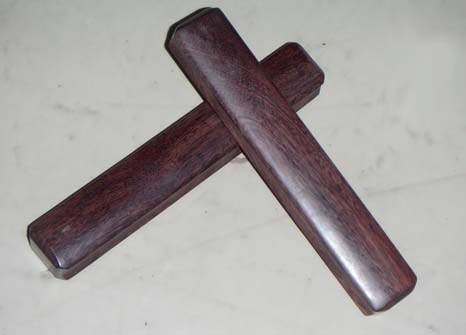 Claves The basic son ensemble of early 20th-century Havana consisted of guitar, tres, claves, bongos, marímbula or botija, and maracas. The tres plays the typical Cuban ostinato figure known as guajeo. The rhythmic pattern of the following generic guajeo is used in many different songs. Note that the first measure consists of all offbeats. The figure can begin in the first measure, or the second measure, depending upon the structure of the song.  Basic son tres guajeo written in cut-time. Playⓘ Later on, the double bass replaced the marímbula and bongos and a trumpet were added, giving rise to sextetos and septetos. |
楽器編成 クラベス 20世紀初頭のハバナでは、ギター、トレス、クラーベス、ボンゴ、マリンブラまたはボティージャ、マラカスで基本的なソン・アンサンブルを構成していた。 トレスは、グアヘオとして知られるキューバの典型的なオスティナートを演奏する。以下の一般的なグアジェオのリズムパターンは、様々な曲で使用されてい る。最初の小節はすべてオフビートで構成されていることに注意してください。曲の構成によって、1小節目から始まることもあれば、2小節目から始まること もある。 カットタイムで書かれた基本的なソン・トレス・グアヘオ。プレイⓘ。 その後、マリンブラに代わってコントラバスが使われるようになり、ボンゴやトランペットも加わり、6重奏や7重奏が生まれた。 |
| Music of Cuba Dance in Cuba |
|
| https://en.wikipedia.org/wiki/Son_cubano |
リ ンク
文 献
そ の他の情報
Copyleft, CC, Mitzub'ixi Quq Chi'j, 1996-2099
☆
 ☆
☆